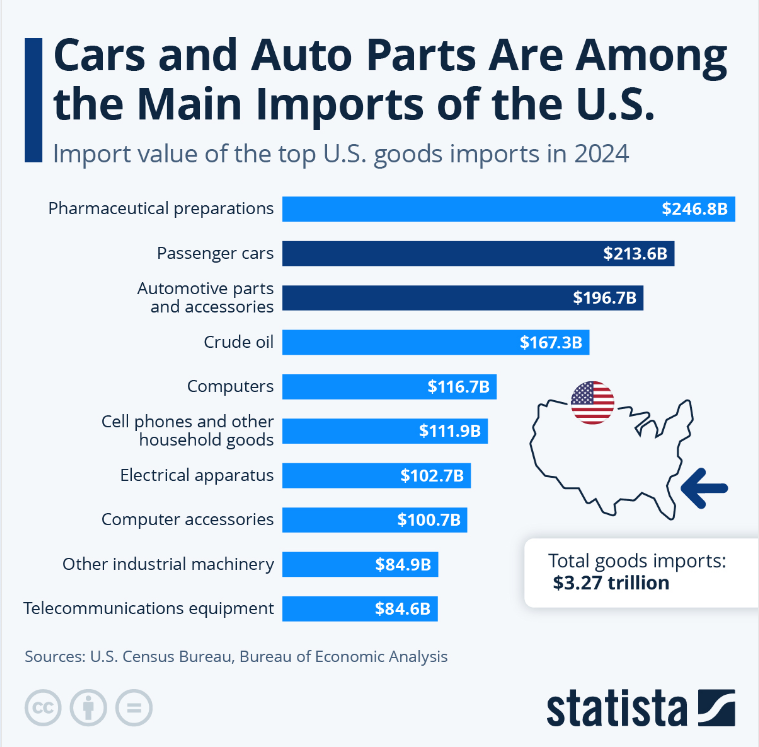The US bond market rallied yesterday amid rising fears that a global trade war is unfolding. The Vanguard Total Bond Market ETF (BND), a proxy for US government bonds and investment-grade credits, rallied to its highest level since September, fueled by a rush for safe havens amid a stock market rout on Thursday. US stocks, by contrast, suffered their worst daily loss on Thursday since 2020, with the steepest declines in tech and energy sectors.
Managing Expectations For A Global Trade War
The sweeping policy change for US tariffs announced yesterday by President Trump is a game changer for the global economy. Exactly how trade flows shift, economies pivot and governments around the world react is unclear, but most forecasts point to slower growth, higher inflation and a reduction in global trade. Trump, by contrast, says the tariffs will “quickly” usher in a new era of prosperity for the US.
Macro Briefing: 3 April 2025
President Trump announced a sweeping set of tariffs on Wednesday that threaten to trigger a global trade war as governments around the world say they will respond. The shift in US policy marks the biggest change to global trade in a century. The core change is a universal tariff of 10% on all imports, plus additional tariffs on the “worst offenders.” A notable exception: Russia. A White House official says Russia is “not on this list because sanctions from the Ukraine war have already rendered trade between the two countries as zero.”
Total Return Forecasts: Major Asset Classes | 02 APR 2025
The long-run expected total return for the Global Market Index (GMI) fell again in March, dropping to an annualized 6.9% vs. the previous month’s 7.1%. The analysis is based on three models (defined below) for GMI, a global benchmark that’s based on a market-value weighted mix of the major asset classes (excluding cash).
Macro Briefing: 2 April 2025
New US tariffs are set to start today, according to the Trump administration. Analysts are hoping that the details will provide more clarity on the policy shift. This much is clear: the stakes are high. “The main channel from trade policy uncertainty to GDP is via business investment. Under higher trade policy uncertainty, future revenue streams of an investment become more uncertain, raising the option value of delaying investment decisions until the situation is clearer,” Oxford Economics analysts said in a research note.

Major Asset Classes | March 2025 | Performance Review
Commodities led widespread rallies in March for the major asset classes, based on a set of ETFs. US assets posted the only losses last month, with American shares leading on the downside.
Macro Briefing: 1 April 2025
Gold rose to another record high on Monday, increasing to $3,124 an ounce. The precious metal has rallied 19.1% so far in 2025.
Equities Demand Higher Risk Premium As Uncertainty Spikes
Measuring shifts in uncertainty is a slippery beast, but it’s easier to intuit when big changes unfold vs. the recent past. We’re knee-deep in one of those moments. One of the tell-tale signs: the US stock market is demanding a higher risk premium to compensate for the spike in uncertainty, a.k.a. prices are falling, which translates to a higher expected return for some forward time horizon.
Macro Briefing: 31 March 2025
US core inflation remained “sticky” in February, based on the core PCE index, which is closely monitored by the Federal Reserve. Core PCE ticked up to a 2.8% year-over-year pace, well above the Fed’s 2.0% inflation target. “It looks like a ‘wait-and-see’ Fed still has more waiting to do,” said Ellen Zentner, chief economic strategist at Morgan Stanley Wealth Management. “Today’s higher-than-expected inflation reading wasn’t exceptionally hot, but it isn’t going to speed up the Fed’s timeline for cutting interest rates, especially given the uncertainty surrounding tariffs.”
Book Bits: 29 March 2025
 ● The Behavioral Portfolio: Managing Portfolios and Investor Behavior in a Complex Economy
● The Behavioral Portfolio: Managing Portfolios and Investor Behavior in a Complex Economy
Phillip Toews
Summary via publisher (Harriman House)
The investment advisory industry is beset by two largely unacknowledged problems. First, the history and risks of both stock and bond portfolios far exceed what most investors and advisory practices can endure. Second, the approach that most advisors take to communicate about portfolios does virtually nothing to prevent investors from known biases and bad decision making. In The Behavioral Portfolio, Felipe Toews guides advisors build all season’s portfolios designed to both invest optimistically and address the real-world contingencies of investing in a high debt world. He begins by re-defining foundational portfolio objectives such such as gains with the market, low risk of extreme losses, and protection against high inflation. He then walks us through the process of quantifying and building these portfolios, illustrating that in so doing, advisors can improve probabilities of success.



